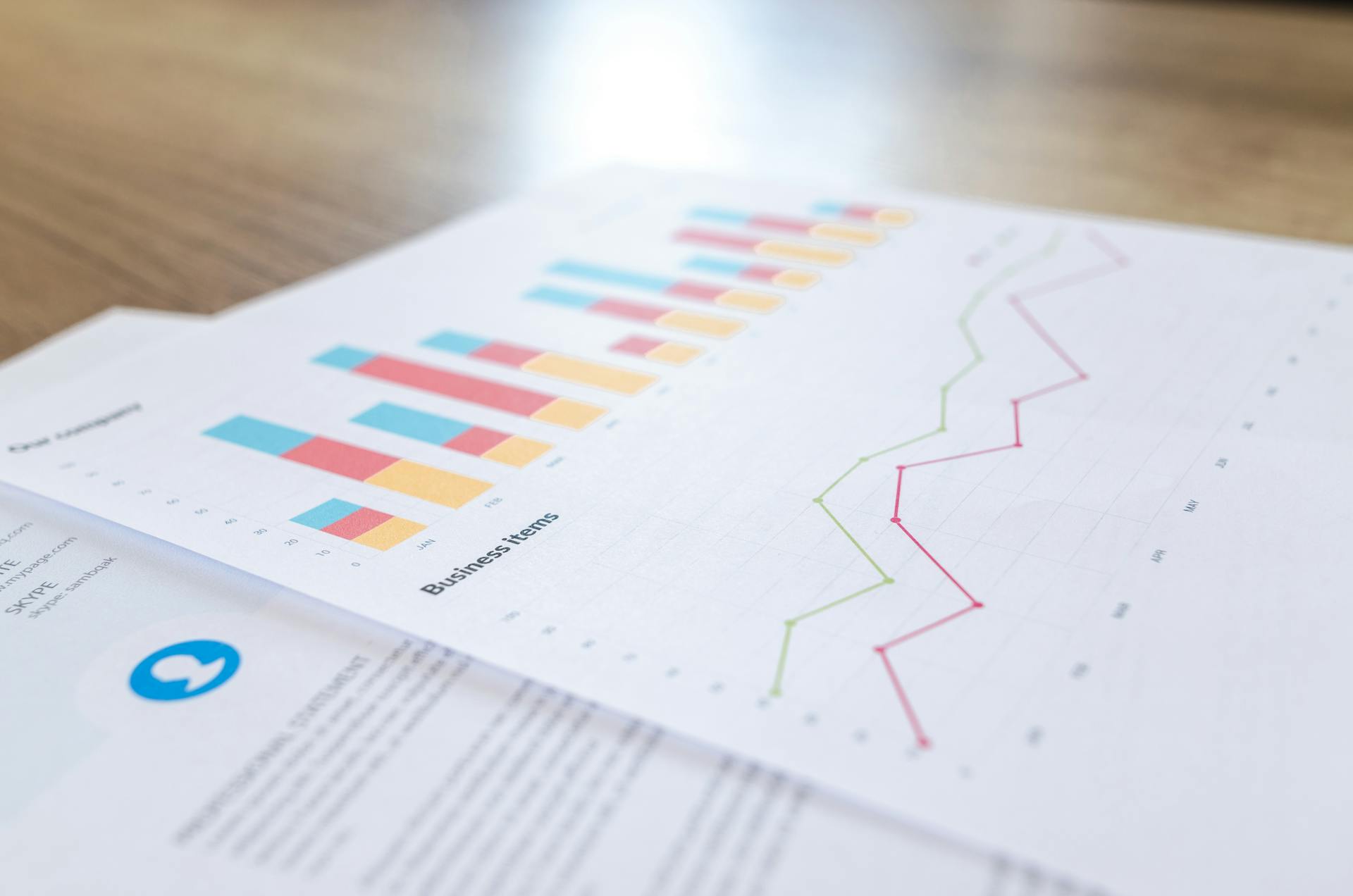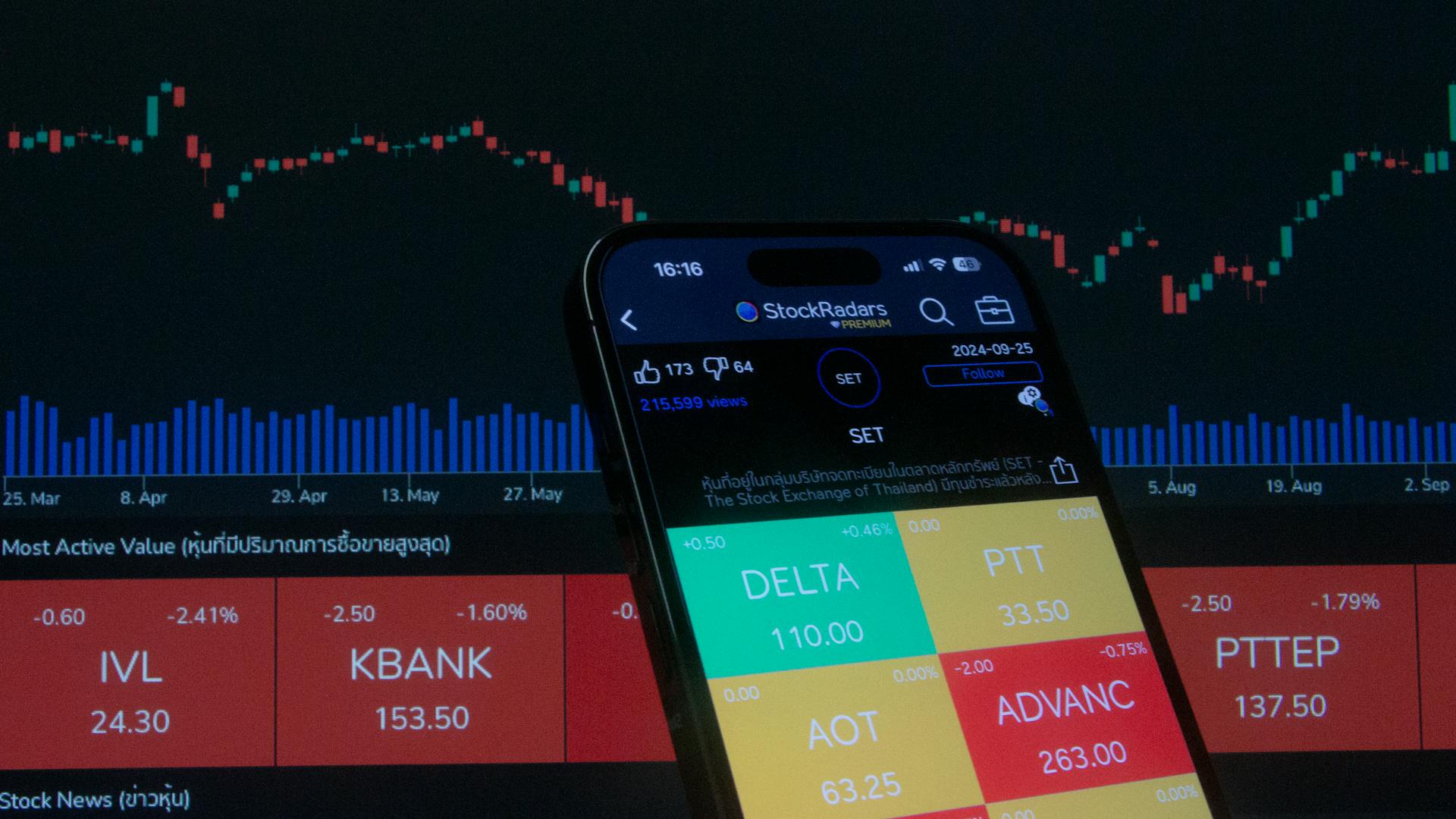
Dividend yield is a crucial factor for investors to consider when evaluating potential investments. A dividend yield of 4% or higher is often considered attractive to income-seeking investors.
Investors can use dividend yield to compare the attractiveness of different dividend-paying stocks. For example, a stock with a 5% dividend yield may be more appealing than one with a 2% yield, assuming all other factors are equal.
Higher dividend yields can indicate a stock's potential for long-term growth. Research has shown that stocks with higher dividend yields tend to outperform those with lower yields over the long term.
However, investors should also be aware that high dividend yields can sometimes be a sign of a struggling company. This is because a company may increase its dividend payout to attract investors, even if it's not sustainable in the long run.
Broaden your view: High Yield Dividend Stocks 2023
What Is Dividend Yield?
The Dividend Yield is a financial ratio that measures the annual value of dividends received relative to the market value per share of a security.
Curious to learn more? Check out: Enterprise Value to Sales Ratio
It's calculated by dividing the dividend paid per share by the current market share price of the issuer, expressed as a percentage. This gives you a clear picture of how much income you can expect from a particular stock.
The dividend yield formula is Dividend Yield = Dividend per share / Market value per share. This is a straightforward calculation that helps you understand the value of your investment.
To break it down further, the dividend per share is the company's total annual dividend payment divided by the total number of shares outstanding. This gives you the amount of dividend each shareholder receives.
Here's a simple formula to remember: Dividend Yield = DPS / Market Value Per Share.
The market value per share is the current share price of the company, which is a key factor in determining the dividend yield.
For another approach, see: Enterprise Value Ratio
Calculating Dividend Yield
Calculating dividend yield is a straightforward process that requires just a few pieces of information. To calculate the dividend yield, you need to know the annual dividend per share and the current market share price.
The formula for dividend yield is simple: it's the annual dividend per share divided by the current market share price, expressed as a percentage. For example, if a company pays an annual dividend of $2 per share and its stock is trading at $100, the dividend yield would be 2%.
To make the calculation easier, it's common to estimate the annual dividend amount by multiplying the latest quarterly dividend amount per share by four. This is because dividends are typically paid quarterly, and this approach reflects any recent changes in the dividend.
Here's a step-by-step guide to calculating dividend yield:
1. Calculate the annual dividend per share by multiplying the latest quarterly dividend amount per share by four.
2. Retrieve the issuer's share price as of the latest closing date.
3. Divide the issuer's dividend per share by the share price.
4. Multiply by 100 to convert the dividend yield into percentage form.
For instance, if a company has a quarterly dividend of $0.30 per share and its stock is trading at $45, the annual dividend per share would be $1.20, and the dividend yield would be 2.7%.
It's worth noting that some companies pay dividends more frequently than quarterly, which can result in a dividend yield calculation that is too low. In such cases, it's essential to look at the history of dividend payments to decide which method will give the most accurate results.
Expand your knowledge: Wells Fargo Announces Quarterly Common Stock Dividend
Here's a summary of the key steps in calculating dividend yield:
Understanding
Dividend yield is a financial ratio that tells you the percentage of a company’s share price that it pays out in dividends each year.
A high or low yield depends on factors such as the industry and the business life cycle of the company. For example, a mature company may report a high yield due to a relative lack of future high growth potential.
Companies that generate consistent and stable profits may be more likely to pay regular dividends. In contrast, companies in high-growth phases may prefer to reinvest profits back into the business rather than distribute them to shareholders.
The dividend yield is an estimate of the dividend-only return of a stock investment. It will rise when the price of the stock falls and fall when the price of the stock rises.
A high dividend yield can offer several benefits to investors, including a steady stream of income, which can be particularly attractive for income-focused investors or those in retirement.
However, there is a risk that the high dividend may not be sustainable, and the company might be forced to cut or eliminate its dividend in the future.
A unique perspective: When Do You Pay Taxes on Dividends
Dividend Yield in Practice
In practice, dividend yield is a useful metric for investors looking to generate regular income from their shares.
A company's dividend yield ratio can be calculated by dividing the total annual dividend payout by the current share price. For example, Company A paid a quarterly dividend of $0.30 per share, resulting in a dividend yield ratio of 2.7% ($0.30 + $0.30 + $0.30 + $0.30) / $45.
Investors often look for companies with a high dividend yield ratio, but it's essential to consider the company's overall financial health and growth prospects.
Company A and Company B, both trading at $100.00 with an annual dividend per share of $2.00 in Year 1, have the same dividend yield of 2.0% ($2.00 ÷ $100.00). However, Company A's dividend yield increases to 4.0% in Year 5 due to a higher dividend payout, while Company B's dividend yield remains the same due to a constant dividend payout.
To illustrate the importance of considering a company's underlying issues, Company B's share price has effectively been cut in half, implying some underlying issues, such as an earnings miss or a negative shift in market sentiment.
You might enjoy: A Current Ratio of 2 Means
Tax and Cost Considerations
Dividends are generally subject to taxes, and the tax treatment can vary depending on the type of account and the investor's personal tax situation.
The tax treatment of dividends in the United States is preferential, with qualified dividends taxed at a lower rate than ordinary income, ranging from 0% to 20% depending on the investor's tax bracket.
Non-qualified dividends, on the other hand, are taxed at the individual's regular income tax rate, which can be substantially higher.
The dividend yield may not ultimately be an investor's rate of return, as taxes can eat into the actual take-home proceeds. For example, if an investor has a high individual tax rate, their true net take-home proceeds may be 20% less than the dividend yield.
To minimize the tax burden on dividend income, investors can employ tax strategies such as holding dividend-paying stocks in tax-efficient investments like index funds and ETFs.
Curious to learn more? Check out: Do You Pay State Taxes on Dividends
Tax Considerations
Dividends are subject to taxes, and the tax treatment can vary depending on the type of account and the investor's personal tax situation.
Consider reading: Is Debt to Income Ratio Pre Tax
In the United States, qualified dividends are taxed at a lower rate than ordinary income, ranging from 0% to 20% depending on the investor's tax bracket.
Dividend income can be impacted by taxes, and investors with high individual tax rates may see their true net take-home proceeds reduced by 20% or more.
Tax-efficient investments like index funds and ETFs can help minimize the tax burden on dividend income.
Foreign investments can lead to double taxation, but the U.S. offers a Foreign Tax Credit to mitigate this.
Holding tax-efficient investments in taxable accounts and investments with a heavier tax burden in tax-advantaged accounts like IRAs and 401(k)s can also help minimize taxes.
Readers also liked: Do You Have to Pay Taxes on Stock Dividends
Cost
Cost is a significant factor to consider when evaluating investments. The yield on cost is a useful metric that shows the return on investment based on the original purchase price.
If a stock splits multiple times, the number of shares increases, but the original investment remains the same. This can lead to a higher yield on cost, as seen in the example where a stock split 2:1 three times, resulting in 8 shares.
Expand your knowledge: Bonus Shares Declared

The yield on cost is calculated by dividing the annual dividend by the original investment. In the example, the yield on cost was 80%, which is significantly higher than the yield with the current price, which was 4%.
A higher yield on cost can make an investment more attractive, especially if the original investment was made at a lower price. However, it's essential to consider the current market price and other factors when evaluating an investment.
For more insights, see: Theoretical Ex-rights Price
Disadvantages
Evaluating a stock based on its dividend yield alone can be misleading. You see, a high dividend yield may not necessarily be a good thing, as it can come at the expense of the company's growth.
High dividend yields may stunt a company's growth, as every dollar paid out in dividends is a dollar not reinvested in the business.
A high dividend yield can also be a sign of a company in distress, with its stock price plummeting. In such cases, the dividend yield can increase dramatically, making it seem more attractive than it actually is.
For your interest: The Current Ratio Measures a Company's

Investors should be cautious when evaluating companies with high dividend yields, especially if their stock is experiencing a strong downtrend. This can amplify the dividend quotient, making it seem more appealing than it actually is.
Here are some key things to keep in mind:
- High dividend yields may stunt a company's growth.
- High dividend yields can be a sign of a company in distress.
- A strong downtrend can increase the dividend quotient.
Related Measures and Formulas
The dividend yield is a key metric used to evaluate a company's dividend-paying ability, and it's closely related to other important measures.
The reciprocal of the dividend yield is the price/dividend ratio.
The dividend yield is connected to the earnings yield through two formulas: earnings yield equals dividend yield times dividend cover, and dividend yield equals earnings yield times dividend payout ratio.
To calculate the dividend yield, you need to know the dividend per share (DPS) and the current share price. The formula is straightforward: DPS divided by the current share price.
Here's a simple example: if a company's DPS is $1.00 and its current share price is $10.00, the dividend yield is 10%.
You can use the following formulas to compare dividend yields among companies:
- Dividend Yield = DPS / Current Share Price
For instance, if Company A has a DPS of $7.08 and a current share price of $29.00, its dividend yield is 24.413%.
Industry and Market Analysis
Industry and market trends can greatly impact dividend yield. The average dividend yield varies significantly between industries, with basic materials industry having the highest average yield at 4.92%.
For example, the basic materials industry has an average dividend yield of 4.92%, while the industrial industry has the lowest average yield at 1.76%. This highlights the importance of considering industry trends when evaluating dividend yield.
Here's a breakdown of the average dividend yield for different industries:
This information can help investors make more informed decisions about their investments.
Across Industries
Across industries, average dividend yields vary significantly, making direct comparisons challenging. The average dividend yield for several industries is as follows:
This highlights the importance of considering industry-specific factors when evaluating dividend yields. A higher dividend yield in one industry may not be as attractive as a lower dividend yield in another industry.
Dow Industrials
The Dow Jones Industrial Average is a significant indicator of the U.S. stock market's strength. Historically, its dividend yield has fluctuated between 3.2% and 8.0%.
The highest ever Dow Jones dividend yield occurred in 1932, yielding over 15%. This was years after the 1929 stock market collapse.
The Dow Jones dividend yield has fallen significantly since the mid-1990s, dropping below its historical low of 3.2%. In 2000, it reached a low of 1.4% during the stock market peak.
The Dogs of the Dow investment strategy focuses on the ten highest dividend yield Dow stocks at the beginning of each calendar year.
Take a look at this: Current Ratio Meaning High and Low
S&P 500
The S&P 500 has seen significant fluctuations in dividend yield over the years, with a notable decline from 6.7% in 1982 to 1.4% in 1998.
This decline was largely due to the rapid increase in stock prices, which outpaced the growth of dividend payments from earnings.
In the 20th century, the highest growth rates for earnings and dividends occurred over a 30-year period, with dividends growing at 6.3% annually and earnings growing at 7.8% annually.
Real Estate Investment Vehicles
Real estate investment trusts (REITs) often have very high dividend yields, but these yields are typically from ordinary dividends, which are taxed as regular income.
These high yields can be misleading, as REITs are required to pass on most of their income to shareholders, a process called a "pass-through" structure.
This structure means that REITs don't have to pay income taxes on profits distributed as dividends, which can artificially inflate their dividend yields.
REITs are not the only real estate investment vehicles with high dividend yields, master limited partnerships (MLPs) and business development companies (BDCs) also often have high yields due to their pass-through structures.
A high dividend yield may not always be the best indicator of a company's financial health, as it may be better off retaining cash to expand its business and reward investors with higher capital gains through stock price appreciation.
Explore further: What Reits Pay Monthly Dividends
Inflation
Inflation can have a significant impact on dividend yields. Companies that increase their dividend yields during inflationary periods can help investors preserve their purchasing power.
During periods of high inflation, corporations that retain cash flow for growth purposes may actually erode the purchasing power of their dividends. This was evident during the global pandemic when the United States saw unprecedented government stimulus that resulted in high inflation.
A stable dividend yield may be unfavorable during inflationary periods if a company decides to retain cash flow for growth purposes. This can lead to a decrease in purchasing power, as seen during the pandemic.
Investors can benefit from dividend yields that increase with inflation, as this can help them maintain their purchasing power over time.
Frequently Asked Questions
Is dividend yield monthly?
No, dividend yield is not calculated using monthly payouts. It's based on annual yields from regular payouts, so check out our Dividend Assistant tool for a more accurate estimate.
What dividend yield is too high?
A dividend yield above 10% is generally considered high-risk, while yields above 4% should be carefully evaluated for sustainability. A high dividend yield can signal potential issues with the stock's value or payout
Is a dividend yield of 3% good?
A 3% dividend yield is considered low for dividend growth investing, as it typically requires solid growth to be attractive. Consider a higher yield or growth potential for a more compelling investment option.
Is 6 dividend yield good?
A 6% dividend yield may seem attractive, but its sustainability is often uncertain. Consider a lower yield with a consistent growth history for more reliable income
What is the difference between annual dividend and dividend yield?
Annual dividend refers to the total dollar amount of dividend payments expected, while dividend yield is the percentage return on investment based on the ratio of annual dividend to share price
Sources
- https://www.wallstreetprep.com/knowledge/dividend-yield/
- https://www.investopedia.com/terms/d/dividendyield.asp
- https://corporatefinanceinstitute.com/resources/accounting/dividend-yield-formula/
- https://www.bankrate.com/investing/dividend-yield-and-how-its-calculated/
- https://en.wikipedia.org/wiki/Dividend_yield
Featured Images: pexels.com


